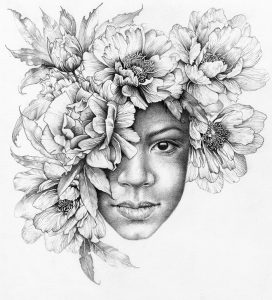This is the third of my folklore-inspired novellas, illustrated by the talented Bonnie Helen Hawkins. It’s very loosely based on two Child Ballads, (Ballad 2: The Elphin Knight, and Ballad 19: King Orfeo), and it’s a kind of gender-flipped reworking of the Orpheus myth, set partly in modern London, partly in the Kingdom of the Fae, and partly in the Kingdom of Death.
Like the previous stories, it stands alone, but it’s set in the same universe as my RUNE books, and my collection of 100 interconnected stories, HONEYCOMB, illustrated by Charles Vess.
Bonnie has really outdone herself this time, with some marvellous illustrations, and Orion’s Sue Gent has designed another tremendous cover.
Like audiobooks? I narrated this one. Click here to hear a clip.
Content warning: suicide; depression; depiction of mental illness
Here are a few pieces I wrote to accompany the release:
Working with Bonnie on Orfeia.
Orfeia, a mother’s grief, and the dark side of fairy tales.
Jealous queens and wicked witches: the role of older women in fairytales.
The Child Ballads: anything but child’s play.
Studying it as part of a reader’s group? Here’s a handy readers’ group guide, with additional resources…
The story:
Fay, grieving over the sudden, tragic death of her daughter, Daisy, refuses to accept her loss. Her search for meaning takes her into London Beyond, and to the court of the charismatic and devious King Alberon, and then onto the Night Train, which carries the souls of the newly dead to the realm of the Hallowe’en King.
But the Hallowe’en King demands a high price for the return of one of his folk. And Fay must confront her forgotten past, as well as her failing memory, if she is to solve his riddles in time to liberate her daughter…
Q & A:
Q: What is it about the Child Ballads that makes you want to explore them?
A: These ballads are part of our folkloric heritage. If you like, they are the UK’s version of Grimm’s fairytales. While historians, clerics and politicians write the histories of our country, folk tales and ballads reflect the lives, the fears and dreams of the people. This makes them just as important, and they deserve to be better known.
Q: Child Ballads are very old. How do you make them relevant?
A: I don’t think the underlying ideas behind these ballads ever stopped being relevant. So many of them deal with universal themes; love, loss, death, grief, childhood, violence, abuse – all these are still totally relevant, and we relate to them in much the same way as people did four or five hundred years ago.
Q: It sounds pretty dark. Is it?
A: It is, rather: although this is ostensibly a fairy story, it’s not a story for children. The fairies in this book – like the ones in HONEYCOMB – are dark and complex, dangerous beings, not at all the Tinkerbell kind. I’m using fairytale imagery here to explore some quite dark psychological issues; Jungian archetypes; the psychology of grief; the shifting nature of memory – all wrapped up in a familiar tapestry of fairytale and symbolism.
Q: Fairytales and psychology – is that an uncomfortable pairing?
A: Not at all, it’s a very familiar one. Fairytales have always been the way in which people expressed thethoughts and feelings for which they had no other words. In a pre-Freudian world, fairytales were often the only way for people to express their deeper feelings. Jung’s psychology is entirely built around the idea of symbolism and archetype: fairytales are full of both. They are the secret language of the human subconscious, and to dismiss them as childish is to miss a vast layer of emotional resonance.
Q: What made you choose an older woman as your heroine?
A: Older women in fairytales seldom have much of a journey. They are usually only ever portrayed as secondary characters: mothers, stepmothers, witches, widows. They don’t get to tell their own stories. This story tries to reclaim the role of the older woman, and her quest for understanding, redemption, agency – even love.
Q: Will there be more of these illustrated books?
A: I think it’s certainly possible. HONEYCOMB (which will be coming out sometime next year) is in some ways, it’s the code book for all these expanded novellas, explaining the world in more detail, and giving these stories more context. But I do enjoy the novella form, and if there’s an appretite for more, then I’d be more than happy to write them…
Want to hear a snippet? Here I am, reading from the first chapter on YouTube…


